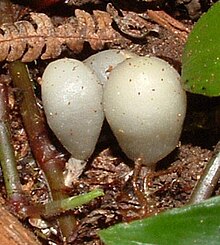Weraroa
| Weraroa | |
|---|---|
 |
|
| Weraroa novae-zelandiae | |
| Scientific classification | |
| Kingdom: | Fungi |
| Division: | Basidiomycota |
| Class: | Agaricomycetes |
| Order: | Agaricales |
| Family: | Strophariaceae |
| Genus: |
Weraroa Singer |
| Type species | |
|
Weraroa novae-zelandiae (G. Cunn.) Singer [as novaezelandiae] |
|
Weraroa is a genus of mushrooms in the Strophariaceae family. The genus was initially described by mycologist Rolf Singer in 1958 to accommodate the single species Secotium novae-zelandiae reported by Gordon Herriott Cunningham in 1924. It has been suggested that the genus may represent an intermediary evolutionary stage between an (underground) ancestor and the related (above ground) genus Stropharia.
Weraroa species are secotioid fungi, meaning that the margin of the pileus never breaks free of the stipe, making them resemble somewhat a pouch on the end of a stem, or stalked-puffball. The peridium (outer wall), which at maturity is , may range in shape from to spherical to or ellipsoid.
The gleba consists of elongated that are various shades of brown. The stipe may also be glutinous, and is continuous with a reaching and merging with the upper peridium, often with a thin veil-like structure that joins the edge of the peridium with the top of the stipe. The context is fleshy and may be gelatinous in the outer portion of the peridium.
Cunningham was first to report that the mushroom takes a long time to mature, and specimens can also persist for long times.
Spores are typically from 10–20 µm in diameter, ellipsoid in shape, smooth, and pigmented ochre to brownish. The basidia (usually 4-spored) often envelop their sterigmata in gastroid-like fashion (i.e., enclosed), and may be narrower in the middle with a broader base. Chrysocystidium are present on the hymenium, on the sterile surfaces of young specimens, and as endocystidia.
Species are usually found in rainforests or wet grasslands, growing on the ground or on wood; species of Weraroa have been found in New Zealand and the United States.
...
Wikipedia
